2016 Peugeot Expert VU fuel
[x] Cancel search: fuelPage 5 of 520

.
.
Driving recommendations 196
Starting-switching off the engine, manual key, remote control
1
99
Starting-switching off the engine, "Keyless
e
n
try and Starting"
2
02
Parking brake
2
05
Hill start assist
2
06
5-speed manual gearbox
2
07
6-speed manual gearbox
2
07
Gear ef ficiency indicator
2
08
Automatic gearbox
20
9
ele
ctronic gearbox
2
14
Stop & Start
2
18
Head-up display
2
22
Memorising speeds
2
24
Speed limit recognition
2
25
Speed limiter
2
29
Cruise control
2
32
Dynamic cruise control
2
36
Collision Risk Alert and Active Safety Brake
2
43
Lane departure warning system
2
48
Fatigue detection system
2
50
Blind spot monitoring system
2
52
Parking sensors
2
55
Reversing camera, interior mirror
2
58
180° rear vision
2
59
Under-inflation detection
2
62Fuel tank
2 65
Diesel misfuel prevention 26
6
Snow chains
2
68
to
wing a trailer
2
69
en
ergy economy mode
2
70
Accessories
271
Roof bars / Roof rack
2
73
Changing a wiper blade
2
74
Bonnet
276
Diesel engine
2
77
Checking levels
2
78
Checks
281
AdBlue
® and SCR system
(BlueHDi Diesel) 2 83
Warning triangle (stowing)
2
87
to
ol box
2
87
te
mporary puncture repair kit
2
90
Changing a wheel
2
96
Changing a bulb
3
03
Changing a fuse
3
16
12 V battery
3
21
to
wing
325
Running out of fuel (Diesel)
3
27Dimensions
328
en
gines
332
Weights
332
Identification markings
3
37
Driving
Practical information
In the event of a breakdownte chnical data
emergency or assistance 338
Pe ugeot Connect Nav 3 41
P
e
ugeot Connect Radio
4
29
Bluetooth
® audio system 4 83
Audio equipment and telematics
Alphabetical index
Contents
Page 6 of 520

4
exterior
Filler cap, fuel tank 265 -266
Misfuel prevention 26 6-267
Running out of Diesel fuel, priming
327
un
der-inflation detection
26
2-264
ty
res, pressures
2
63 -264, 337
e
SC programme
1
61-163
ABS,
e
B
FD
1
62
DSC, ASR
1
63
gr
ip control
16
3, 16 4 -165
Snow chains
2
68
Front doors
7
4-75
AdBlue
® tank 28 3-286to
ol box 2 87-289
Automatic illumination of headlamps
1
49
Automatic headlamp dipping
153 -15 4
Direction indicators 1
48
Manually adjusting the headlamp beam height
1
55
Changing front bulbs
3
03-309
Headlamp wash
1
58
op
ening the bonnet
2
76 Key
47
Key, remote control
4
7-54
Changing the battery, reinitialisation
5
4
Keyless e
n
try
and Starting
5
5-71
Changing the battery, reinitialisation
7
0
Starting - switching off the engine, key, remote control
1
99 -201
Starting - switching off the engine, Keyless e
n
try and starting
2
02-204
Locking / unlocking from inside
7
2-73
Alarm
95-97
Speed limit
recognition
225-228
Collision Risk Alert
2
43 -245
Active Safety Brake
2
43, 246 -248
Fatigue detection
2
50-251
Changing a wiper blade
2
74
Automatic wiping
1
57-158
Front demisting, defrosting
1
32
Front foglamps
1
47, 309
Daytime running lamps
1
49, 305
Cornering lighting
1
52
Parking sensors
2
55-257
to
wing
325-326
over view
Page 12 of 520
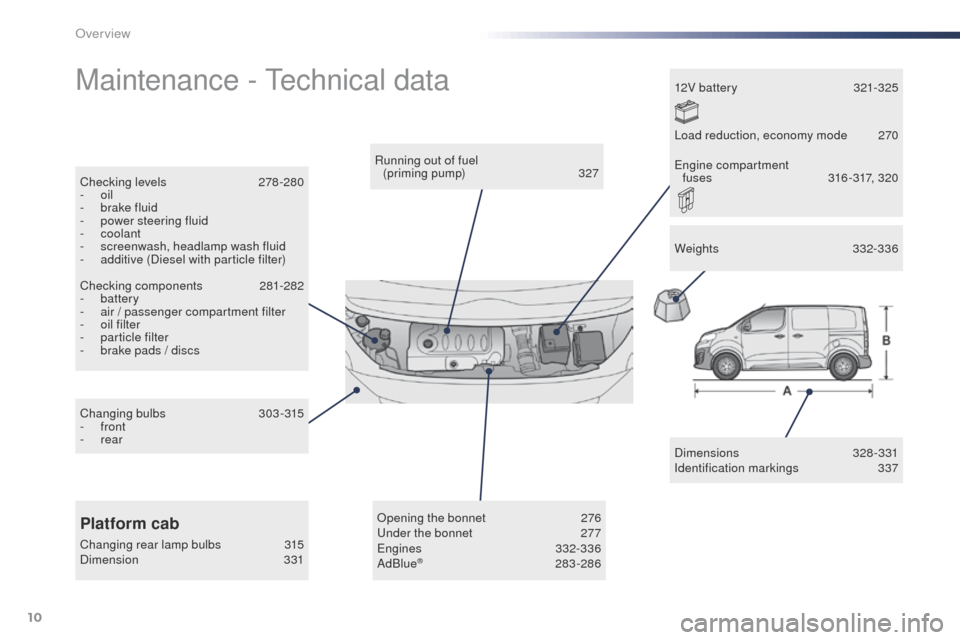
10
Maintenance - technical data
Dimensions 328-331
Identification markings 3 37
Running out of fuel
(priming pump)
3
27
Checking levels
2
78 -280
-
oil
-
b
rake fluid
-
p
ower steering fluid
-
coolant
-
s
creenwash, headlamp wash fluid
-
a
dditive (Diesel with particle filter)
Checking components
2
81-282
-
battery
-
a
ir / passenger compartment filter
-
o
il filter
-
p
article filter
-
b
rake pads / discs
Changing bulbs
3
03-315
-
front
-
rear
Platform cab
Changing rear lamp bulbs 3
15
Dimension 3 31 12V battery
32
1-325
op
ening the bonnet
2
76un
der the bonnet 2 77en
gines 332-336
AdBlue® 283-286 W eights
332-336
Load reduction, economy mode
2
70
en
gine compartment
fuses
3
16 - 317, 320
over view
Page 14 of 520
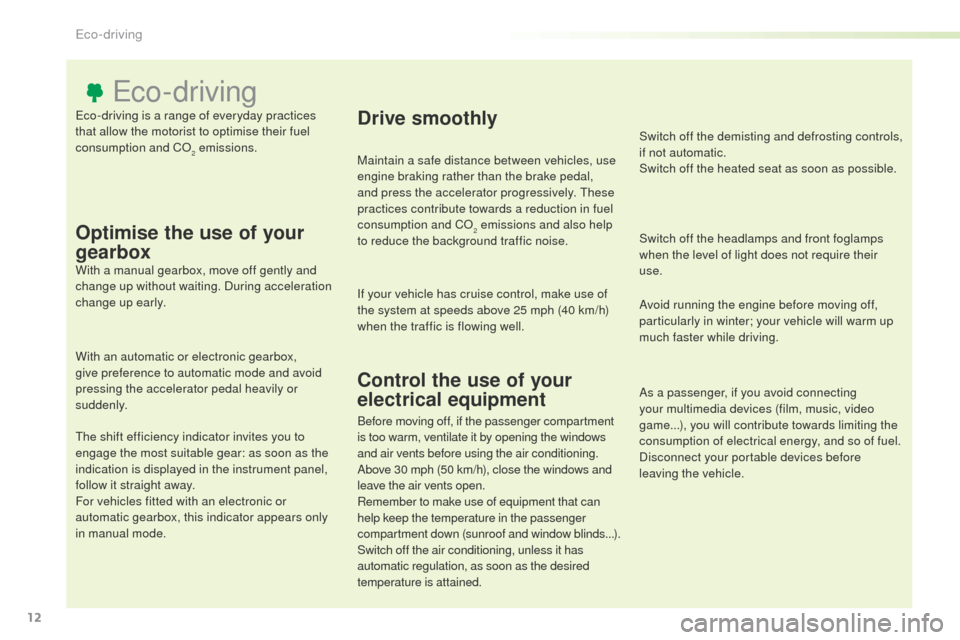
12
eco-driving is a range of everyday practices
that allow the motorist to optimise their fuel
consumption and Co
2 emissions.
eco-driving
Optimise the use of your
gearbox
With a manual gearbox, move off gently and
change up without waiting. During acceleration
change up early.
With an automatic or electronic gearbox,
give preference to automatic mode and avoid
pressing the accelerator pedal heavily or
suddenly.
th
e shift efficiency indicator invites you to
engage the most suitable gear: as soon as the
indication is displayed in the instrument panel,
follow it straight away.
For vehicles fitted with an electronic or
automatic gearbox, this indicator appears only
in manual mode.
Drive smoothly
Maintain a safe distance between vehicles, use
engine braking rather than the brake pedal,
and press the accelerator progressively.
t
h
ese
practices contribute towards a reduction in fuel
consumption and C
o
2 emissions and also help
to reduce the background traffic noise.
If your vehicle has cruise control, make use of
the system at speeds above 25 mph (40 km/h)
when the traffic is flowing well.
Control the use of your
electrical equipment
Switch off the demisting and defrosting controls,
if not automatic.
Switch off the heated seat as soon as possible.
Switch off the headlamps and front foglamps
when the level of light does not require their
use.
Avoid running the engine before moving off,
particularly in winter; your vehicle will warm up
much faster while driving.
As a passenger, if you avoid connecting
your multimedia devices (film, music, video
game...), you will contribute towards limiting the
consumption of electrical energy, and so of fuel.
Disconnect your portable devices before
leaving the vehicle.
Before moving off, if the passenger compartment
is too warm, ventilate it by opening the windows
and air vents before using the air conditioning.
Above 30 mph (50 km/h), close the windows and
leave the air vents open.
Remember to make use of equipment that can
help keep the temperature in the passenger
compartment down (sunroof and window blinds...).
Switch off the air conditioning, unless it has
automatic regulation, as soon as the desired
temperature is attained.
eco-driving
Page 15 of 520
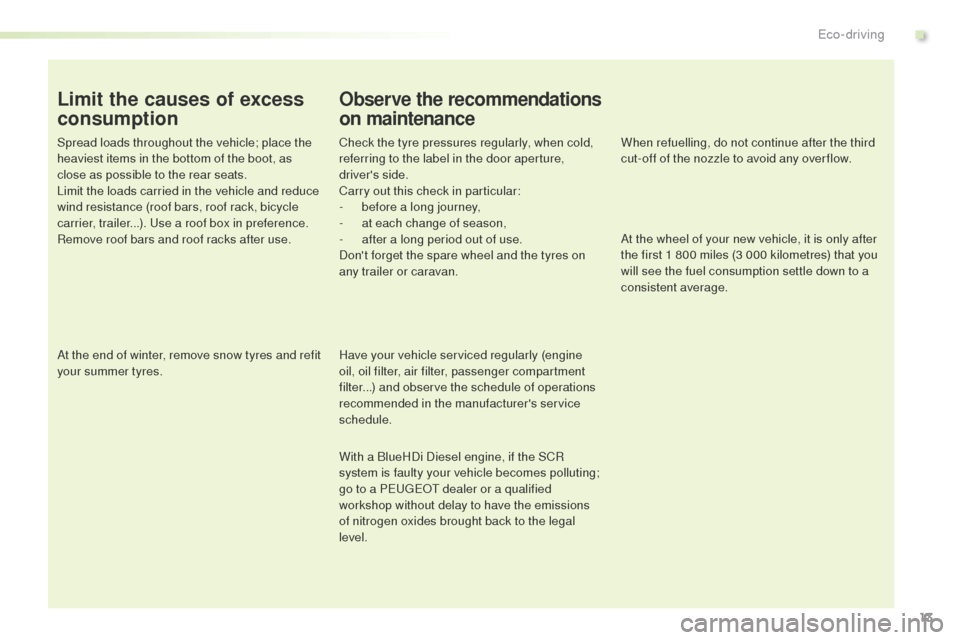
13
Limit the causes of excess
consumption
Spread loads throughout the vehicle; place the
heaviest items in the bottom of the boot, as
close as possible to the rear seats.
Limit the loads carried in the vehicle and reduce
wind resistance (roof bars, roof rack, bicycle
carrier, trailer...). u
s
e a roof box in preference.
Remove roof bars and roof racks after use.
At the end of winter, remove snow tyres and refit
your summer tyres.
Observe the recommendations
on maintenance
Check the tyre pressures regularly, when cold,
referring to the label in the door aperture,
driver's side.
Carry out this check in particular:
-
b
efore a long journey,
-
a
t each change of season,
-
a
fter a long period out of use.
Don't forget the spare wheel and the tyres on
any trailer or caravan.
Have your vehicle serviced regularly (engine
oil, oil filter, air filter, passenger compartment
filter...) and observe the schedule of operations
recommended in the manufacturer's service
schedule.
With a BlueHDi Diesel engine, if the SCR
system is faulty your vehicle becomes polluting;
go to a P
e
ugeot dealer or a qualified
workshop without delay to have the emissions
of nitrogen oxides brought back to the legal
level. When refuelling, do not continue after the third
cut-off of the nozzle to avoid any over flow.
At the wheel of your new vehicle, it is only after
the first 1 800 miles (3 000 kilometres) that you
will see the fuel consumption settle down to a
consistent average.
.
Eco-driving
Page 17 of 520
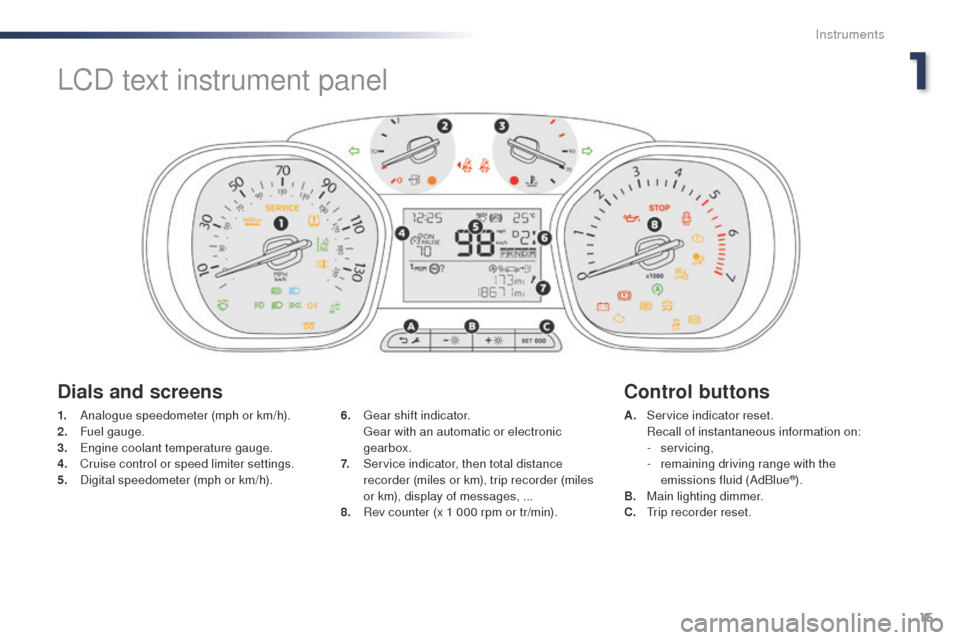
15
1. Analogue speedometer (mph or km/h).
2. Fuel gauge.
3.
e
ng
ine coolant temperature gauge.
4.
C
ruise control or speed limiter settings.
5.
D
igital speedometer (mph or km/h). A. S
ervice indicator reset. R
ecall of instantaneous information on:
-
servicing,
-
r
emaining driving range with the
emissions fluid (AdBlue
®).
B. M
ain lighting dimmer.
C.
t
r
ip recorder reset.
6.
g
e
ar shift indicator.
g
e
ar with an automatic or electronic
gearbox.
7.
S
ervice indicator, then total distance
recorder (miles or km), trip recorder (miles
or km), display of messages, ...
8.
R
ev counter (x 1 000 rpm or tr/min).
Dials and screens Control buttons
LCD text instrument panel
1
Instruments
Page 18 of 520
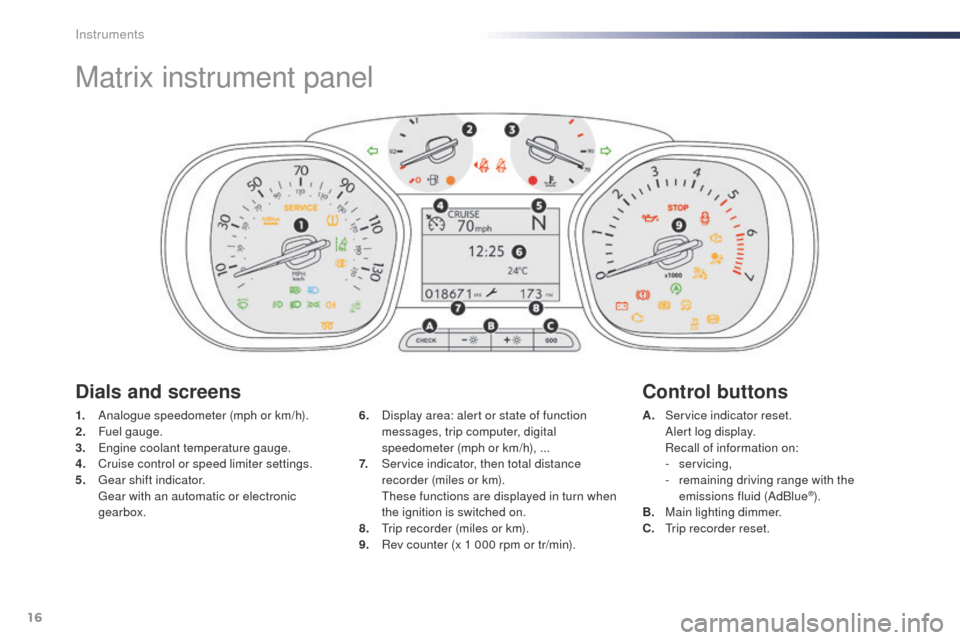
16
Matrix instrument panel
1. Analogue speedometer (mph or km/h).
2. Fuel gauge.
3.
e
ng
ine coolant temperature gauge.
4.
C
ruise control or speed limiter settings.
5.
g
e
ar shift indicator.
g
e
ar with an automatic or electronic
gearbox. A. S
ervice indicator reset. A
lert log display.
R
ecall of information on:
-
servicing,
-
r
emaining driving range with the
emissions fluid (AdBlue
®).
B. M
ain lighting dimmer.
C.
t
r
ip recorder reset.
6.
D
isplay area: alert or state of function
messages, trip computer, digital
speedometer (mph or km/h), ...
7.
S
ervice indicator, then total distance
recorder (miles or km).
th
ese functions are displayed in turn when
the ignition is switched on.
8.
t
r
ip recorder (miles or km).
9.
R
ev counter (x 1 000 rpm or tr/min).
Dials and screens Control buttons
Instruments
Page 22 of 520
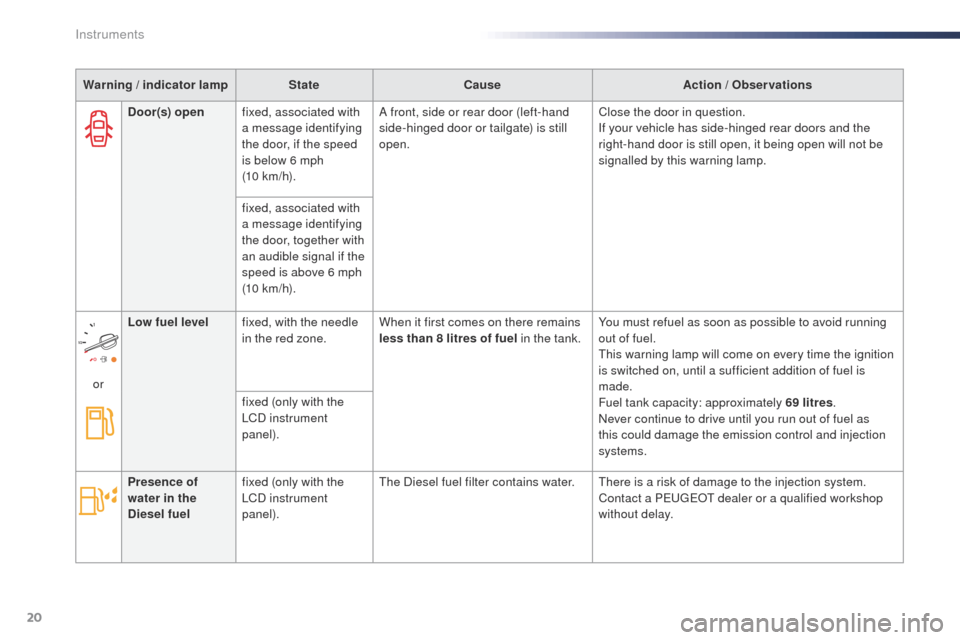
20
Warning / indicator lampStateCause Action / Observations
Door(s) open fixed, associated with
a message identifying
the door, if the speed
is below 6 mph
(10 km/h). A front, side or rear door (left-hand
side-hinged door or tailgate) is still
open.
Close the door in question.
If your vehicle has side-hinged rear doors and the
right-hand door is still open, it being open will not be
signalled by this warning lamp.
fixed, associated with
a message identifying
the door, together with
an audible signal if the
speed is above 6 mph
(10 km/h).
or Low fuel level
fixed, with the needle
in the red zone. When it first comes on there remains
less than 8 litres of fuel
in the tank.You must refuel as soon as possible to avoid running
out of fuel.
th
is warning lamp will come on every time the ignition
is switched on, until a sufficient addition of fuel is
made.
Fuel tank capacity: approximately 69 litres .
Never continue to drive until you run out of fuel as
this could damage the emission control and injection
systems.
fixed (only with the
LCD instrument
panel).
Presence of
water in the
Diesel fuel fixed (only with the
LCD instrument
panel).
th
e Diesel fuel filter contains water.
th
ere is a risk of damage to the injection system.
Contact a P
e
ugeot dealer or a qualified workshop
without delay.
Instruments